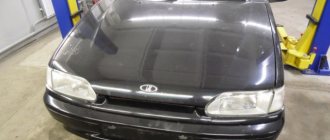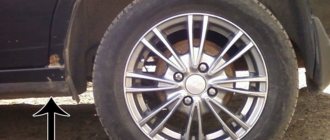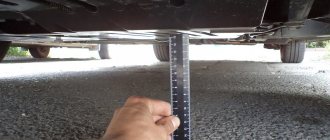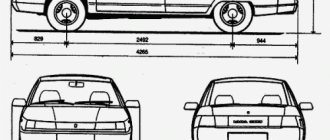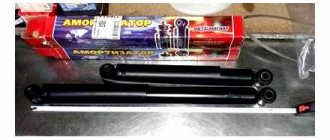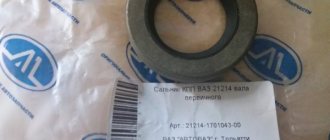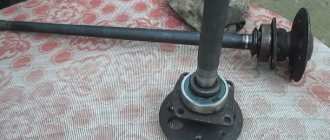Over time, as they wear out, the car's standard suspension springs become less rigid.
Excessive “softness” of the suspension leads to deterioration in handling on uneven roads, and the rubber bumpers of the suspension are triggered even when driving over small bumps. This applies to all cars, and the “seven” is no exception. There are two ways to solve the problem:
- Replace the springs with new, stiffer ones.
- Install spacers under the springs of the VAZ 2107.
The second method is simpler and less expensive. If necessary, it allows you to increase the stiffness of even new springs.
There are several types of spacers:
- Interturn spacers.
- Spacers between the spring and the installation cup on the car body.
- Spacers between the spring support and the mounting cup.
- Spacers on adjustable suspension.
Below we will look at the features of each type separately.
Spacers for springs VAZ 2107 dimensions
It's no secret that Zhiguli sedans, from VAZ-2101 to 2107, have a common weakness - rear suspension springs.
Probably chosen for “comfort” reasons, they work acceptably when the machine is not very loaded. And under full (albeit within normal) load, they are compressed so much that on an uneven road the rear axle beam can hit the bump stops. This can also be caused by problems with the shock absorbers, especially if the car is far from new. Over time, due to changes in the structure of the metal, the stiffness of the springs also decreases - they sag, the compression stroke becomes very small, and under heavy loads almost disappears. In general, as a movie character would say, with such springs there is no life! Placing spacers under the springs will not really solve the problem. Firstly, metal fatigue takes its toll - and one day the spring simply breaks. Secondly, frequently repeated impacts destroy the bump stops; in addition, cracks appear in body parts, especially if the spring is compressed before the coils collide. That is why the installation of rubber spacer rings, although it increases cross-country ability, is still rather self-deception.
There are also rubber inserts on sale that are designed to be installed between the coils of a weakened spring. Their main drawback is the same as that of spacers; Let's add fragility to this.
Meanwhile, springs from the VAZ-2104 station wagon are allowed to be installed on the Zhiguli sedan. These springs are 21 mm longer - hence the additional load capacity.
There is another option - however, which did not receive the go-ahead from VAZ - replacing the standard rear springs with rear springs from Niva.
The table shows the basic data of various springs.
Changing the length of springs depending on the load. Keep in mind: there are products on the shelves whose data, to put it mildly, do not correspond to those given in the table. They often turn out to be longer than even those intended for the VAZ-2104 and, moreover, differ in the number of turns.
When installing station wagon springs on sedans, the clearance in the rear suspension area increases by approximately 20 mm over the entire vehicle load range. Before the bump stops touch, you can load 40 more kilograms into the car than with standard springs. However, gradually the sagging of the springs will sooner or later negate this gain. (More likely, it’s too early, because the spare parts are not of high quality.)
When installing the rear springs of a Niva, the clearance on an empty car will also increase - almost the same as when installing springs from a VAZ-2104. However, with a further increase in load, the clearance will decrease significantly less. For example, before the bump stops touch the car, you can load 90 kg more than with standard springs. In addition, the amplitude of vibrations of the rear suspension will decrease - the suspension will become stiffer.
Disadvantages - increased load on the body, which can lead to premature cracks, and increased wear of standard shock absorbers during rebound. Indeed, with a heavy load and normal rebound motion, the “shot” force is much higher. And with a small load, the rebound stroke decreases - the car seems to stand on tiptoes, although the spring force is normal. If we remember the principles of suspension operation, it is clear that the “orchestra” is somewhat upset. Here the shock absorbers, in an amicable way, need different ones, with higher rebound resistance. Thus, the car enthusiast has several options to choose from.
If the car is used in traveling mode - with a light load and on good roads, then the best solution is to replace the sagging springs with the same new, standard ones. If you sometimes have to load it properly, then springs from a station wagon are better. Well, when using the car as a delivery vehicle, rear springs from the Niva are preferred (taking into account the note about shock absorbers).
The rear springs on the VAZ-2104 can also be replaced with Niva springs - the load capacity will increase and the sway will be slightly reduced.
It is more convenient to replace sagging springs together with an assistant in a pit or overpass, using ordinary keys. But if you come across abnormal, long springs, you may need devices - ties to compress them.
Installing “original” springs, as a rule, does not cause complications, but to install longer or stiffer ones, additional measures must be taken.
Over time, the car's standard springs sag, become shorter, their stiffness and the mechanical properties of the metal of the springs change. The comfort of a car's suspension with such springs becomes much worse, the softness disappears when going over uneven surfaces, and the wheels begin to touch the body even when not fully loaded. There are options when the car is operated in difficult conditions, off-road, constantly with an increased transport load.
The solution to the problems described above has several options: - replacing the standard springs with new ones, with the option of installing reinforced new springs (if such are produced for your model). This is the most expensive and effective method; – install spacers under the shock absorbers. See the article " - install spacers under the springs. Spacers are usually cheaper than springs; they are varied in their design and application.
In this article I would like to touch upon the topic of using these spacers for springs on a car to restore or increase ground clearance. Let's start with perhaps the simplest spacers and the easiest way to install them. Intercoil spacers can be installed on the springs of the rear or front suspension. In fact, they do not change the ground clearance, but change the spring stiffness. With their use, the suspension becomes more rigid, which allows for greater loads without changing the ground clearance. Photos of such interturn spacers for springs are shown below.
Photo 1. Appearance of interturn spacers for springs. Photo 2. Interturn spacer installed on a spring Such spacers have the least efficiency, but maximum ease of installation. One of the wheels of the car, with the help of a house card, is suspended and the springs diverge.
The spacers are tucked between the turns using a screwdriver and hands. Before installing the spacers, it is better to wash them with soapy water, and also install them in a warm room or in the summer, since the plasticity of rubber at high temperatures is much higher than the plasticity at low temperatures. This method of increasing ground clearance was officially applied to cars of the “classic” family (VAZ 2101-2107) and Muscovites. Enlarged spacers have similar installation dimensions for the body cup and for the spring coils, but have a larger face-to-face length. In the photo below you can see a reinforced spacer on the left and a standard spacer on the right. The difference between the spacers in height is 30 mm, that is, this is the size by which the ground clearance will increase after installing reinforced spacers.
Installation of spacers is carried out when removing the springs from the car; instead of the standard one, a reinforced one is installed. The photo does not show the metal plate installed on the spacer, on which the spring rests. This method is the most effective compared to the previous one.
Used for rear suspension types: torsion beam, axle beam, longitudinally linked arms, for front double wishbone suspension, multi-link suspension. See article » This option is used for the MacPherson strut front suspension, when the strut rotates with a shock absorber, spring, and support when turning. The spacer is installed on the upper surface of the support, on the part that previously rested on the body cup. Subsequently, the entire assembly is installed in its place. To fasten the spacers, use longer bolts, which are usually included in the kit. Installation is carried out by removing the rack and installing a spacer between the body and the rack.
Front shock absorber VAZ 2107
The suspension design of any car uses shock absorbers to increase the comfort and safety of movement. Since VAZ 2107 shock absorbers, like other suspension elements, are subject to constant loads and fail over time, you need to know how faults manifest themselves and be able to replace the part if necessary.
Purpose
The normal and correct operation of the front suspension of the “seven”, and the rear one too, is ensured by the main structural elements - a spring and a shock absorber. The spring softens the shocks of the body while the car is moving. When hitting any kind of obstacle (potholes, bumps), the wheel comes off the road, and thanks to the elastic element it returns to work. When the wheel hits the surface, the body presses down with its entire mass, and the spring should make this contact as soft as possible. The work of the shock absorber is aimed at dampening vibrations of the elastic element as quickly as possible when the body rocks. The part is completely sealed and, when fully operational, is capable of absorbing about 80% of impact energy. The shock absorbers of the front suspension of the VAZ 2107 are attached with the lower eye through the bracket to the lower suspension arm. The damper rod is fixed through the support glass using a nut.
Table: parameters of standard front shock absorbers VAZ 2107
| vendor code | Rod diameter, mm | Case diameter, mm | Body height (excluding stem), mm | Rod stroke, mm |
| 21012905004, 21012905402 | 12 | 41 | 215 | 112 |
What are spring spacers and why are they needed?
Spacers are such devices - liners that are installed in the suspension structure. Their installation allows you to solve many different problems. They can be intended to increase ground clearance, or to increase the stiffness of springs that have sagged, as well as for tuning the car.
Spacers can be installed in both the front and rear springs of a VAZ 2107. If you often have to transport heavy loads in a car, then installing inserts is mandatory. The use of the devices in question allows you to increase the weight of the cargo transported in the car. They are made from a dense and durable material that is designed to withstand heavy loads. Moreover, this material is not metal, but polyurethane, ABS plastic, aluminum or rubber.
Before installing inserts on a car, you need to understand their types, as well as their distinctive features.
The materials used for manufacturing must be distinguished not only by high strength, but also by resistance to the negative influence of the external environment. That is why rubber, polyurethane, plastic and aluminum materials are used for manufacturing. Most often, polyurethane or rubber reinforced spacers are used to increase ground clearance.
To make a choice, you need to understand what types of spacers are produced and how they differ.
Interturn spacers for car suspension springs
This is the most common option for solving the problem of soft suspension on a VAZ 2107. The advantages of such inserts include factors such as ease of installation and versatility. Moreover, interturn spacers can be installed not only in the front, but also in the rear springs. Interturn spacers cannot increase the clearance, which is their peculiarity.
Interturn rubber bands are easy to install, since they do not require removing the springs from the car or special devices. It is due to this advantage that interturn devices are popular. The principle of their installation is that you need to jack up the car, remove the wheel, stretch the spring coils and install an insert in the gap.
Spacer between spring and mounting cup
The second installation option allows you to increase ground clearance. This type of device is placed between the body part and the spring. The thickness of the insert is the size by which the vehicle's ground clearance can be increased after installing the inserts. When installing inserts between the spring and the mounting cup, the rebound stroke of the shock absorber is reduced.
To take advantage of this option for increasing the ground clearance and rigidity of the VAZ 2107, you should pay attention to two important factors - the absence of corrosive deposits at the location of the insert, as well as the serviceability of the spring. It must be in good working order, and not completely sagging, otherwise the effect of using the element will be zero.
There are polyurethane or rubber devices. The difference between them is that rubber is softer, but has a short service life. Polyurethane lasts longer, but the suspension also becomes noticeably stiffer. Structurally, such ground clearance increases are rings with metal washers.
To install this type of device, you will need to jack up the car, remove the wheel, compress the spring with special brackets, and then install a spacer between the body and the spring. Then release the staples and put everything back together.
Interturn spacers for car suspension springs
These spacers have the simplest designs and are very easy to install.
They can be used on rear and front suspension springs. The use of interturn spacers makes it possible not to change the vehicle's ground clearance, while increasing the stiffness of the springs. As a result, the springs can carry a greater load without sagging to unacceptable limits. This is not the most efficient spacer design, but it can be quickly installed without the use of special tools. To install the interturn spacer, it is enough to jack up the wheel and spread the spring as far as possible. The part can be mounted using a regular screwdriver. To make the spacer easier to insert, it must first be moistened in soapy water.
How to install spacers under a spring
Before starting work, you need to decide what the ground clearance should be. So, for example, for passenger cars the ground clearance should be 145 - 200 mm.
Important: the installation of spacers for springs in the front and rear of the vehicle is different, so you need to take into account all the intricacies of such work.
Installing spacers for the front suspension
In this case, it is recommended to use rubber inserts, since they partially offset the disadvantages associated with increasing ground clearance. Further work is carried out in several steps:
1. A clean car is placed on a flat surface and raised with a jack.
2. The front wheels are removed, the stabilizer struts and brake hoses are detached.
3. The fasteners on the front pillar are unscrewed, and then new bolts are screwed into the structure.
4. An attachment is installed on the new fasteners, after installation of which all removed parts are assembled.
Please note: the work will require a spring tie, an adjustable wrench, a safety stand and wrenches.
Installing rear suspension spacers
It is also recommended to use rubber products for the rear springs. Before their installation, preparatory work is carried out:
- Removing the thresholds located at the trunk and rear doors.
- Latching the rear seats and removing the trim in the trunk.
- Lifting the car.
All other steps are identical to the process of installing parts for the front springs. To visually familiarize yourself with the principles of installing spacers, you can watch the video:
Replacing the front shock absorber on the “seven”
When damaged, front suspension dampers are usually replaced with new ones. Sometimes owners try to repair them on their own, which requires some experience, the purchase of a repair kit and special oil, but only dismountable shock absorbers are suitable for such a procedure. Before you start replacing, you need to decide which elements to install on your car.
Selection of shock absorbers
The question of choosing dampers for the “seven” is quite difficult for many, which is due to the wide variety of such products. The following types of shock absorbers can be installed on the “classic”:
- oil;
- gas-oil with constant hardness;
- gas-oil with variable hardness.
Each type is characterized by its pros and cons and is produced by different manufacturers. It is necessary to select a product based on the operating conditions of the vehicle and the driving style of the owner.
Oily
Although the “seven” is basically equipped with oil shock absorbers filled with hydraulic fluid, many are not satisfied with their performance. The main disadvantage of such dampers is their slow response. If the car moves at high speed, the shock absorber does not have time to return to working condition, which leads to swaying on the springs. Therefore, they are recommended for those owners who do not operate their cars at speeds exceeding 90 km/h.
Gas-oil
Gas-oil shock absorbers use oil and gas, which increases the operating efficiency of the product and improves handling of irregularities. The main working medium is oil, and gas stabilizes operation by removing excess foam and increasing the efficiency of response to changes in road conditions. Equipping Zhiguli cars with such dampers has a positive effect on driving performance. There is virtually no sway at relatively low speeds. Among the minuses, it is worth highlighting omissions during sharp impacts.
Gas-oil with variable hardness
On the “Seven”, as well as on other “classics”, such elements are practically not installed, which is due to the high price. Products of this type are equipped with a special valve with an electromagnet. By means of the valve, it is adjusted to the operating mode of the vehicle and the amount of gas in the main cylinder of the damper is adjusted with a change in the rigidity of the device.
Video: types of shock absorbers and their differences
Manufacturers
During repairs, many owners install standard elements. Those who want to improve the performance of the suspension purchase gas-oil components. However, you have to choose from foreign manufacturers, since domestic ones do not produce such products. The most popular brands include:
Table: analogues of front dampers for VAZ “classics”
| Manufacturer | vendor code | price, rub. |
| KYB | 443122 (oil) | 700 |
| KYB | 343097 (gas) | 1300 |
| Fenox | A11001C3 | 700 |
| SS20 | SS20177 | 1500 |
| Sachs | 170577 (oil) | 1500 |
How to remove
To dismantle a faulty shock absorber we will need:
The event consists of the following actions:
- We hang the front of the car using a jack.
- Open the hood, unscrew the upper shock absorber mount in the mudguard hole using a 17 key, holding the rod with a 6 key.
Video: replacing front end dampers on classic Zhiguli cars
How to prepare for installation
The process of installing shock absorbers on a VAZ 2107 does not cause any difficulties. However, for proper and long-term operation they need to be prepared - pumped. Since the procedure differs depending on the type of device, we will dwell in more detail on the preparation of each of them.
Bleeding oil shock absorbers
We pump oil-type dampers according to the following algorithm:
- We install the product with the stem down and gradually compress it.
- We wait a few seconds, holding the part with our hands in the same position.
Bleeding gas shock absorbers
The procedure for dealing with gas dampers is as follows:
- Turn the part over with the stem down.
- Smoothly recess the rod and fix it for a few seconds.
- Turn the product over again and hold for no more than 6 seconds.
- Fully extend the stem.
- We turn the part over, pause for a couple of seconds and repeat steps 1–4 several times.
- We finish pumping at step 4.
- To check the performance of the part, perform step 7 on pumping the oil shock absorber.
Video: preparing gas-oil shock absorbers for operation
How to put
It is recommended to fully extend the rod before installing the shock absorber. If the damper was removed due to wear of the rubber pads or silent block, we replace them with new ones. Installation is carried out in the reverse order of removal.
If the front shock absorber of your "seven" fails, you do not have to contact a service center for help - the repair can be done on your own without special tools and extensive experience in carrying out procedures of this kind. To replace the damper, it is enough to familiarize yourself with the algorithm of actions and follow them during operation.
Adjustable suspension spacer
This type of spacers is used to allow the vehicle's suspension to be adjusted.
Adjustable spacers on the VAZ 2107 cannot be called practical. They are used only by car tuning enthusiasts. The cost of such spacers is equal to the cost of several new sets of springs for the “classic”, so from the point of view of economy it is easier to replace the suspension springs.
Adjustment of the suspension equipped with such spacers is carried out by rotating the support platform along the threads fixed to the support base. To prevent the support pad from rotating on its own, it is secured with a screw. This changes the ground clearance and suspension stiffness.
This type of spacer is very “capricious” - the ingress of moisture and dirt can quickly damage it due to thread corrosion. The use of stainless steel in such spacers does not solve the problem - this material is too soft and viscous. Therefore, once you have set the required ground clearance, you may not be able to turn the support pad the next time.
Article: 2101-2912652, additional articles: 2101-2912652Р
Order code: 793504
- Buy with this product
- show more
- Buy analogues
- Passenger cars / VAZ / VAZ-21022 drawings
- » href=»/catalog/vaz-3/legkovye_avtomobili-30/vaz_2102-4/podveska_zadnyaya-148/#part7791″>Upper suspension gasket / rear suspension
- » href=»/catalog/vaz-3/legkovye_avtomobili-30/vaz_2102-4/podveska_zadnyaya-147/#part7771″>Upper suspension gasket / rear suspension
- Passenger cars / VAZ / VAZ-21041 drawing
- » href=»/catalog/vaz-3/legkovye_avtomobili-30/vaz_2104-5/podveska_zadnyaya-117/#part14742″>Upper suspension gasket / rear suspension
- Passenger cars / VAZ / VAZ-21061 drawing
- » href=»/catalog/vaz-3/legkovye_avtomobili-30/vaz_2106-7/podveska_zadnyaya-128/#part21103″>Upper suspension gasket / rear suspension
- Passenger cars / VAZ / VAZ-21211 drawing
- » href=»/catalog/vaz-3/legkovye_avtomobili-30/vaz_2121-13/podveska_zadnyaya-120/#part59980″>Upper suspension gasket / rear suspension
- Passenger cars / VAZ / VAZ-212131 drawing
- » href=»/catalog/vaz-3/legkovye_avtomobili-30/vaz_21213-731/podveska_zadnyaya-159/#part2010945″>Upper suspension gasket / rear suspension
- Passenger cars / VAZ / VAZ-21012 drawing
- » href=»/catalog/vaz-3/legkovye_avtomobili-30/vaz_2101-3/podveska_zadnyaya-148/#part3307″>Upper suspension gasket / rear suspension
- » href=»/catalog/vaz-3/legkovye_avtomobili-30/vaz_2101-3/podveska_zadnyaya-147/#part3287″>Upper suspension gasket / rear suspension
- Passenger cars / VAZ / VAZ-21032 drawings
- » href=»/catalog/vaz-3/legkovye_avtomobili-30/vaz_2103-106/podveska_zadnyaya-114/#part11352″>Upper suspension gasket / rear suspension
- » href=»/catalog/vaz-3/legkovye_avtomobili-30/vaz_2103-106/podveska_zadnyaya-113/#part11331″>Upper suspension gasket / rear suspension
- Passenger cars / VAZ / VAZ-21051 drawing
- » href=»/catalog/vaz-3/legkovye_avtomobili-30/vaz_2105-6/podveska_zadnyaya-117/#part17848″>Upper suspension gasket / rear suspension
- Passenger cars / VAZ / VAZ-21071 drawing
- » href=»/catalog/vaz-3/legkovye_avtomobili-30/vaz_2107-8/podveska_zadnyaya-167/#part25332″>Upper suspension gasket / rear suspension
- Passenger cars / VAZ / VAZ-21311 drawing
- » href=»/catalog/vaz-3/legkovye_avtomobili-30/vaz_2131-73/podveska_zadnyaya-208/#part64859″>Upper suspension gasket / rear suspension
- Passenger cars / VAZ / VAZ-21213-214i1 drawing
- » href=»/catalog/vaz-3/legkovye_avtomobili-30/vaz_21213_214i-1240/podveska_zadnyaya-212/#part2990308″>Upper gasket Suspension / Rear suspension There are no reviews for this product yet.
Pay for goods by credit card, using QIWI, Yandex.Money or WebMoney and save on your purchase from 4%, avoiding postal and bank commissions
This product was chosen by 30 customers
Installing spacers under the shock absorbers will allow you to raise the rear so that the car, when fully loaded, does not touch the wheel arch liners with its rear wheels.
Note! The color of the spacers is sent randomly.
Weight, kg: 0.7 Dimensions, cm: 14 x 8 x 7 Volume, m3: 0.00078
Video: Installing Spacers Under the Front Springs of a VAZ 2107
Appearance of standard and reinforced spacers
Installed on site
Installation of spacers is carried out when removing the springs from the machine, instead of standard reinforced spacers. Not shown in the photo is the metal plate mounted on the spacer on which the spring rests. This method is the most effective compared to the previous one. They are used for the rear suspension type: twist beam, axle axle, longitudinally connected arms, for front double crossbars, multi-line suspension. See the article “Types of vehicle suspension”
Spacers between the spring support and the cup body
This setting applies to a MacPherson strut where the strut rotates with the shock absorber, spring and pivot. The gasket is installed on the top surface of the support, on the part that previously rested on the housing cup. Subsequently, the entire collection is replaced.
The longer bolts are usually used to attach the spacers that are usually included in the kit. Installation is accomplished by removing the rack and installing spacers between the chassis and the rack. The material of such spacers is different: metal, polyurethane, caprolon. Coil spacers are also provided. Unlike the ones described above, they are no longer attached to screws passing through them, but have a second set. The first mounting kit is attached to the support, the second. to the cup body. Photo below.
MacPherson coil gaskets
Adjustable suspension spacer
Although this topic is indirectly related to the topic of the article, the principle of adjustable suspension also affects the use of different pads. It's no longer a matter of practicality, but of a hobby, car tuning. The cost of such structures, as a rule, exceeds several sets of springs. Adjustment of the suspension and change of clearance is carried out by twisting the support platform along the thread on the support base. See photo below
The rotating support platform is secured with a screw. Spacers are quite capricious; they do not tolerate moisture or dirt, since the threaded surfaces can quickly become useless. When using stainless steel, such spacers usually require additional thread coating (chrome plating). And the point is not that stainless steel is not a corrosive material, but that it is a very soft and tough material. Once you have adjusted the spacers and aligned the car, the second time you can no longer move the adjuster foot. Here, in principle, all the main spacers that are currently used in the suspension are installed on the same axial axis with the spring.
Pros and cons of increasing clearance
Among the positive aspects of changing the clearance it is worth highlighting:
- quick replacement of spacers, including products made of other materials. It is necessary to take into account that you need to maintain symmetry - on the left and on the right there should be spacers made of the same material without differences in characteristics (preferably - the same model and manufacturer);
- low cost of work and materials;
- the ability to carry out manipulations independently.
There are also negative points:
- relative fragility of materials - regular replacement is required. The service life depends on the material used, the frequency of trips and the nature of driving;
- when the ground clearance increases too much, the suspension is likely to deflect, increasing the load on the shock absorbers and damaging the brake hoses;
- The wiring of the ABS sensors and other components is likely to be disconnected.
Balance must be maintained when increasing the ground clearance both in front and behind the car.
This type of spacer is intended for use in the rear suspension of the VAZ 2107. In this case, the so-called “increased spacers” are used. They have the same installation dimensions for the spring coils and body cup, but are thicker. The enlarged spacers are 30 mm thicker than the standard ones, which allows you to increase the vehicle's ground clearance by this amount.
To install such parts, it is necessary to remove the springs, so their installation is a more complex and time-consuming operation than installing interturn spacers. But this is a more effective and reliable way to increase the spring stiffness and ground clearance of the car. A similar design of spacers is used not only on the VAZ 2107. They are used with torsion bar and axial beam suspensions, in suspensions with longitudinally linked arms, in double wishbones and multi-star suspensions.
Spacer between spring support and body mounting cup
These types of spacers are used in MacPherson-type front suspensions, in which the strut rotates along with the shock absorber, spring support and the spring itself when the wheel turns. The part is installed at the top of the support, where it rests on the body cup and the finished assembly is installed in place.
To fix the spacer, bolts are used, the length of which is longer than the standard ones. To install, you have to dismantle the rack. Such spacers are made of metal, polyurethane or nylon. The effectiveness of this type of spacers is as high as the spacers between the spring and the cup. You can make them yourself or purchase them in a store.
Shock absorber malfunctions
Any car malfunction always manifests itself in the form of extraneous noise, unusual behavior of the vehicle or other signs. Problems with shock absorbers also have certain symptoms, and if they are detected, you should not delay replacing the dampers.
Oil leakage
The most common sign that a shock absorber has become unusable is a fluid leak. Leaks on the body indicate a loss of seal in the oil reservoir. As a result, not only leaks occur, but also air leaks. In this case, the damper rod has free movement, i.e. it moves without any effort, and the part loses its functionality. If signs of smudges have just appeared on the shock absorber, it will serve a little longer, but you should not leave it without attention and it is better to replace it in the near future.
Body rocking
Since springs and shock absorbers work together to dampen vibrations that occur when driving over bumps, contact with the road may be lost if the damper fails. In this case, shaking increases, the body sways, and the level of comfort decreases. The car becomes rolly, and when it hits obstacles it sways for some time. The easiest way to check the shock absorbers of your “seven” is to press the wing, try to rock the body, and then release it. If the car continues to swing on the springs for some time, then this is a clear sign of a faulty damper.
Body roll
One symptom that indicates problems with the suspension shock absorbers is body roll when cornering. This behavior of the car negatively affects safety, since the quality of braking, as well as vehicle control, suffers. If liquid has leaked from the damper, it will be quite difficult to keep the car turning, which is especially dangerous in winter. When the mileage of the products in question is more than 60 thousand km, which also depends on the quality of the parts themselves and the operating conditions of the vehicle, handling may noticeably deteriorate. But since the process does not occur at one moment, but gradually, the driver practically does not notice this and rolls can be perceived as a normal phenomenon.
Suspension noise
Extraneous sounds in the suspension, uncharacteristic of its operation, indicate the need to check and service this mechanism. When dampers and their bushings wear out, the ability to effectively support the weight of the machine is lost. In addition, so-called shock absorber breakdowns often occur.
Suspension breakdowns are metal elements touching each other, which leads to a knocking sound.
Uneven or increased tire wear
If it has been noticed that the tire tread has uneven wear or wears off too quickly, then this is a clear sign of problems with the suspension. With faulty shock absorbers, the wheel moves vertically with a much greater amplitude, which leads to uneven tire wear. When driving, extraneous noise appears on such wheels.
Plunging when braking
Among car owners there is such a thing as “the car bites.” If the dampers fail, the front of the car will dive during braking, and the rear will sag when accelerating. This is explained by the fact that parts that have become unusable do not cope with their function, that is, they do not support the weight of the machine.
Broken fastening
One of the infrequent breakdowns of the front shock absorbers is the breakage of the lower eye. The reasons for this phenomenon may be different:
- installation of low-quality parts;
- making changes to the standard suspension design.
Homemade spacers
Any spacers are structurally simple, so they are not difficult to make. Moreover, this process is quite creative.
Some make them by simply cutting them out of an old tire, others use ebonite, steel, polyurethane and other materials.
Any tools are good for making. At home, a drill, jigsaw, files, etc. may be useful for this.
Those who have the opportunity to use a lathe simply turn them from blanks.
In general, any suitable material can be used for manufacturing, and it can also be processed with different tools and equipment. The only important condition is compliance with the dimensions.
For cutting, you can try to find drawings, and if they are not there, then focus on the dimensions of the components of the suspension (for example, a spacer for a spring is made based on the diameter of the spring itself and its seat).
In general, if you want to make spacers at home, it is quite possible.
How do spacers affect the suspension with different installation methods?
There are several ways to increase ground clearance using spacers. So, similar products can be installed:
- under the springs;
- for shock absorbers;
- under the racks.
Let's take a closer look at the effect of spacers on vehicle performance in each of the above cases.
- Spacers for springs . Many car owners believe that installing spacers on springs reduces the controllability and stability of the vehicle. They are partly right, since increasing the ground clearance due to spacers for springs makes the suspension softer, which increases the car's roll during sharp turns and can lead to skidding or overturning. However, firstly, such a nuisance can only occur with an aggressive driving style and at speeds above 100 km/h. And secondly, if the work on installing spring spacers was carried out in compliance with all the standards and requirements that apply to this process, then you will feel comfortable on roads with any quality of road surface and when driving at any speed.
- Spacers for shock absorbers . When installing spacers on shock absorbers, the stroke of the rods changes, which negatively affects the shock-absorbing properties of this part - as in the case of springs, the suspension becomes softer and does not fully perform its functions. However, if you lengthen the shock absorber by an amount equal to the thickness of the spacer, then the installation of such products will in no way affect the basic characteristics of the car.
- Spacers for racks . Installing spacers on racks can lead to a violation of the rigidity and reliability of the structure, which will affect its shock-absorbing properties and wear resistance. But, as in the above cases, if the work on installing spacers was carried out in compliance with certain standards, then the installation of such products will not in any way affect the driving performance of the vehicle and the wear rates of its components.
You can learn more about how to install spacers in this or that case from this article.
Which is better spacers or reinforced springs: analysis of motorists' opinions
Having analyzed a large number of automobile forums, our company’s specialists, based on feedback from motorists, came to the following conclusion: installing reinforced springs helps to increase the vehicle’s ground clearance without much effort, which significantly increases its cross-country ability. However, among the disadvantages of installing such products, motorists note a significant decrease in the speed characteristics of the vehicle, as well as the lack of a feeling of “sticking” of the car to the road surface at high speeds. As we described above, all these troubles can be avoided if you buy spacers and entrust their installation to qualified specialists.
Therefore, the conclusion, in our opinion, is clear - spacers are superior to reinforced springs in their performance properties.
Purpose of rear springs on VAZ 2107
Rear springs are essential for a comfortable ride. They are the most important part of the suspension and successfully dampen the shaking that occurs when driving on uneven roads. The springs also prevent the car from tipping over when entering a very sharp turn. And finally, when driving on a flat road, the springs keep the car body at a constant height.
The rear spring on the VAZ 2107 is located far behind the wheel
Externally, the spring is a rod made of structural steel and twisted into a spiral. The suspensions of the very first cars were equipped with springs. But now almost all cars have springs, because they take up less space in the body and are easier to maintain. In addition to springs, the VAZ 2107 also has shock absorbers, the main task of which is to dampen vibrations resulting from the operation of the spring.
About the stiffness of car springs
Speaking about the purpose of springs, one cannot help but dwell on such an important characteristic as rigidity. Car enthusiasts usually divide suspensions into “hard” and “soft”. The VAZ 2107 uses both types of suspensions. And their use is determined by the purpose of the machine.
Spring stiffness depends on many different parameters
If the owner of the “Seven” loves speed and prefers an aggressive driving style, he installs a stiffer suspension, which makes the car as stable as possible on sharp turns. And if the driver is not used to rushing, then he should install a soft suspension that provides maximum comfort when driving on uneven roads. The stiffness of the “seven” springs depends on the following parameters:
- diameter of the spring rod. As the diameter of the rod increases, the stiffness of the spring also increases;
- diameter of the spring itself. Spring diameter refers to the diameter of the cylinder formed by a twisted spring rod. The larger this diameter, the softer the spring will be;
- number of turns. The more turns in the spring, the softer it is;
- form. Springs can be cylindrical, barrel-shaped or conical. Cylindrical ones are considered the hardest, barrel-shaped ones are the softest, and conical ones occupy an intermediate position between cylindrical and barrel-shaped ones.
